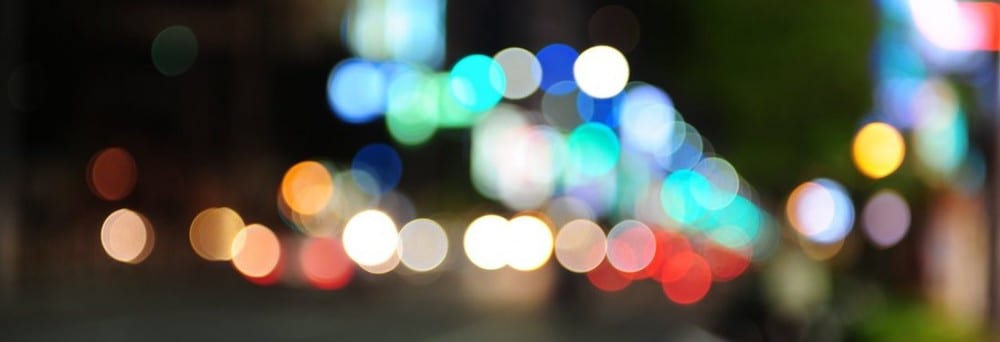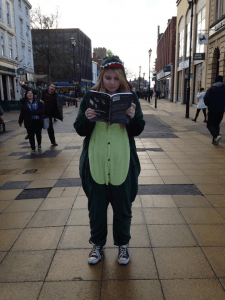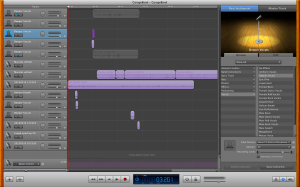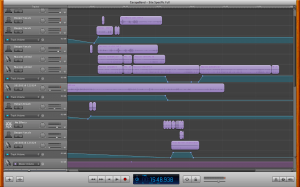Collision is a soundscape and at its heart is a liberation of the sounds of Lincoln from the city itself. Following a classical framework the piece takes form of becoming quiet at the start, only slow and calm collisions. Then a third of the way in the mayhem commenced. To an extent there is a closeness in mayhem, Tim Etchells describes as, “There are strange intimacies in the city.”(Tim Etchells, 1999, 79), the collision shows how hectic the city can be but also how beautifully in tune. In this section collisions come from all different ways, trains, barriers, laughing, enough to make someone go insane then just as it was too much we cut it off and sent them back in to the slightly too calm ending, the purgatory soundscape.
The nature of the soundscape meant that the practicalities of our performance were different to a normal site specific performance as we were in a black box studio. It was our aim to be on the site, Lincoln city centre high street, but it transpired that because of the context we set ourselves the soundscape worked better through speakers in the studio than headphones when walking along the high street. This way were able to isolate just one audience member at a time. We expected the audience to focus on the soundscape in an analytical way as well as allowing them to get lost in the distorted city. William Davis describes listening to soundscapes as, “’listening in search’ as a form of analytical listening, where the individuals focussed upon hearing sounds relating to their activity.” (Davis, 2009, 18) The individual would not be relating to the activity but the principle is still the same, ‘listening in search’ applies to our performance.
William Davis is a great influence for us in this way as different types of listening enables our audience to be enveloped in the soundscape. Other influences throughout the process were John Drever for his outstanding work on soundwalking. He is able to explore all manner of spaces with trust from his audience’s, having that trust was the main focus of Drever inspiration. “Once the group has assembled the walk leader sets the scene and prepares the walkers. This could include a discussion on listening methods…” (Drever, 2011, 2) Drever seems to have a connection to his audience that we wanted to mirror with ours, whether it be a connection to us or to a connection to the soundscape. Another influence was Mike Pearson, having such a huge impact on site specific performance, we felt that we needed to explore his work when working on ours. Pearson’s view’s on ‘Place’ supports our thesis, Pearson says “Beyond providing a metaphor for social, process, aesthetics performance might itself be place-making.” (Pearson, 2010, 109) we are combining Pearson’s views of place-making within a studio space with our own atmospheric twist. A less theatrical influence we used was Freud. At first, because our idea was slightly different it was more of a dreamscape we felt Freud would have a individual insight into the inner workings of the dreams. “In sleep the mind isolates itself from the external world.” (Freud, 1978, 53) We wanted to isolate the audience even at the start the our process. Although we did want to keep the element of isolation and disillusion in it somehow.
DREAMSCAPE
Chloe dressed as dinosaur to signify dreamscape in high street, February 2015
Dreamscape is something we have been exploring to connect with the Lincoln high street. Dreams are such an interesting concept, they effect everyone and the idea those dreams could be liberated onto the high street in some way is an incredible idea in itself. Chloe and I have concluded that an intense audio experience is an idea we want to explore because we feel that exposing audiences to that part of their subconscious could be so innately shocking yet wonderful. We discovered in a task in which we had to pick one of 25 projects that this would be an exciting venture particularly for us. Our task transpired with Chloe dressed in a dinosaur onesie walking up and down the high street. We did this to see what people’s reactions would be. Some were ignorance, some were angry at her and some actually shouted abuse at Chloe. How this ties into our dreamscape is were trying to see how something completely obscure and dreamlike would fit into the high street and how people would react to said object or person. Freud writes that, “The belief is held in antiquity that dreams were sent by the gods in order to guide” (Freud, 1978, 75) This was not the reception we got but we still feel that there is promise in the idea of a dreamscape.
When workshopping ideas we showed our partly improvised 3 minute dreamscape piece left us with feedback that it enabled the audience to create their own version of the city within their own imaginations. The audience also responded well to the background audio track we created, saying it contrasted with my slower and calming voice we felt that this is something that could be more deeply explored. When exploring this further we have found Freud’s theories could have some relevance to our performance. For example, “Dreaming, he writes, ‘is a natural activity of the mind which is not limited to the power of individuality’” (Freud, 1978, 82) It seems human to dream if to dream to bring such emotion to the body. That is the sort of emotion that we want to bring to a person just walking down the street. This concept is so interesting to us because dreams seem to be at the heart if a person, they can be what we thought this route was best because it was the most noticeable part of the high street, where people shop and have a coffee with friends. This route, plus twist, turns and stops along the way. We were going to walk around the war memorial, the markings on the stones seems so significant to Lincoln, yet they are faint like a memory or a dream. People would recognise it but not recognise the sound therefore it will make the journey all the more intense. Crabman and Signpost’s expertise really are useful in this area. They seem in tune to how their site and the people inhabit it intertwine. They explore their site as zones, “We adopted the street as as a zone of encounters; an affordance for meeting with the street’s workers, walkers…” (Crabman and Signpost, 2011, 20) After reading A Sardine Street Box of Treats, walking the site has enabled me to have a different perceptive. To have greater connection with the high street. I have found ways to explore through a tour, whether it be audio or otherwise, a version of a city that is personal to the individual.
FALLING DOWN THE RABBIT HOLE
After weeks of the dreamscape not quite going to plan because we felt the material was lacking, we decided to keep the idea of an audio track but change the rest of the bigger idea into a soundscape in a studio. The reasoning for this was as we sat waiting for a meeting to discuss the rotting idea of our dreamscape, we realised if we isolated the audience as well as slightly more warped sounds from the high street we could get a falling down the rabbit hole effect. The idea came to be much before this point, before I was in a group. I wanted to explore the notion endless possibilities complete warped disillusion. We want people to feel a renewed sense of wonder on the high street, even if it’s just a seconds thought. As we also had the chance to be in Frequency festival in which the theme was liberation I thought that the idea of a audio track in which an audience member is being liberated from the very city around them would be something Frequency would be very interested in. Directly from Frequency’s website this is what they expect from new artists, “Our hope is that we can start to discover the unusual, unique and cutting edge and use this as a platform for curating and commissioning for future Frequency Festivals to come.” (Frequency ’13, 2015) This was something we could aim to with the falling down the rabbit hole idea.
When discussing the new idea with our tutor we realised that Studio One was the best space to use. As it is a black box space and easily interchangeable. It is also a safer space for a more risky project Pearson says, “Place is a space in which vows have been exchanged, promises have been made and demands have been issued.”(Pearson, 2010, 108) We thought if we guided the audience around the space then they still may get the feeling of a site but within this distorted, warped sense of being, they would be in limbo instead of on the high street like any other performance.
What made the soundscape/ falling down the rabbit hole effect come together was the 20 or more different sounds Chloe and I recorded from the high street itself. This sound from the coffee shop is one we started off with,
which of course was a great background noise but we felt we needed something more like the train barriers,
to create more of punch when it came to the editing process. Collecting and listening to so many sounds enabled us to dig deeper into soundwalking, even if it was in a studio we would still be taking our audience’s on journey’s. We came across a practitioner called Stephan Crasneanscki. He has worked on site’s all around the world and has created collaborative soundscapes with all manner of people. “During the last 10 years, Soundwalk has collected, distilled and re-interpreted sounds from all over the world to create immersive sound journeys, radically modern in their conception.” (Soundwalk, 2015) taking note of the way that Crasneanscki had edited and explored his sound in modern sense we felt we needed to really expose the deepest distortion we could then work back from there. We felt it best to work this way as in the end the work would seem clearer and more refined.
Our Collision
Neither myself nor Chloe knew a lot about editing so this part of the process was always going to be challenging. With the support of peers we started by using Logic Pro and GarageBand. We were only lucky enough to use Logic Pro for one session and we did make some progress on the McDonald’s track. This is what it sounded like
This was to be one of our background or white noise tracks. We stretched out the track and put reverberation sounds on it. This session taught us a lot of other useful skills for the rest of the editing process and we were now aiming for a much higher quality of track. Funnily enough it was Tim Etchells Eight Fragments that caught my attention when thinking about editing, “We always loved the incomplete – from the building site to the demolition site, from the building that was used once and is no longer to the building that will be used.” (Etchells, 1999, 78) the ‘incomplete’ and indeed ‘complete’ are something that go hand in hand in editing as the tracks are cut to pieces but somehow we were coming up with a melody that was enabling us to create a real soundscape. The reasoning behind this section of the process is clear, to create soundscape that was atmosphere and led people down a strange and unknown road.
GarageBand, Creating Process, Collision, April 2015.
This image shows a section of work that we worked on, on the left one can see the number of tracks that we used, this demonstrates the skill we gained from changing various tracks on GarageBand as well as using Audacity. We used both as we felt it would be best for soundscape if we got the sounds one can get from GarageBand, this can seen on the right of the image. On Audacity though one can get a whole different range of sources, it is better at stretching and speeding up tracks which will be predominate in our final piece.
Audacity, Creating Process, Collision, April 2015
Audacity was a tricky program to grasp but after teaching ourselves we were able to explore in greater detail how the it worked. For example we sped up a track 100% and slowed a 10 minute track down to 2 hours. We also changed the levels of vocals which gave specifically the laughing tracks a strange feel to it.
GarageBand, Creating Process, Collision, May 2015.
This is much further along in the process so it is clear that we have become better equipped with software. We could change the volume of the tracks, fade them in and out and split them when we needed to. For example, I split then looped the coffee track that we had earlier worked on in Audacity and it sounded beautiful under that sound of the train with the ‘beeswax’ vocals on top too. The whole process was a lot smoother and it is clear from this image that our performance will show skill as well as atmospheric intent.
Meetings to make it Final
Once we had our first draft of Collision we showed it to our tutor and got a lot of constructive notes, by that point we were able to deal with the software quite easily so it was long but necessary learning curve we had to make. Some of the notes were that it was too busy and we did not need to be afraid to use pauses and silences. This is something we definitely thought about when doing the first draft but got caught up with the melody of the high street. When getting these notes I thought best to read up on practitioners that did the same sort of work like Lundahl & Seitl I realised they worked one to one with audience members, which after discussion was now our plan and we would definitely just have them in a seat in the middle of the room as the soundscape would be so intense. When reading through Lundahl & Sietl’s work I realised how much we could be influenced by them and how much they could help our performance. Although theirs is site-specific it is all audio and has a undertone of eeriness that ours has running throughout, “The work takes the visitor on a walk, through physical and virtual places. An hour may have passed, maybe two. An autumn. A winter.” (Lundahl&Sietl, 2015) Their work mirrors our sense of limbo, the audience member could be anywhere, any time. I think that is why I instantly recognised with them and wanted to learn from them.
As we went in with our second draft we were told that we had gone too far the other way. We had stripped it back and made it too much of a waste land. So as instructed we made followed a classical structure. We split it into three, it started calm, relaxed then as we built up the tracks the soundscape got more hectic and unbearable. Then the third phase of almost too still or calm then a few strange noises come in from different places to confuse you slightly. The middle section in particular with the “Who’s next please?” on a loop and laughing seem to have and impact. But then there was the more serene collisions like the slowed down till at the beginning, it is much less agitated but still as powerful within the piece.
We decided on the day of performance to test it out once each so Chloe and I both took turns leading each other in. I was not ready for the power of it. I think the train barriers effected the most because they are so Lincoln in a way, they were they one thing amongst the chaos and serenity that reminded that I was not just in limbo. I am glad we got to test it out in the studio first for a technical point of view but also from an artistic one it was special to be able to hear the soundscape myself and Chloe had been working on for so long sound so perfect.
This is Collision
When others participated in Collision anticipation set in every time, would they like it? Would they even get the soundscape? When the markers were done taking part in Collision, there was a sense of relief, although they did seem to really enjoy they construction of the piece and certain sounds definitely stuck out to them like the slowed down till at the beginning because it seemed to perfect for the performance. We ended up having six audience members all together which seemed just the right amount seeing as the piece was so personal. Their feedback was that the soundscape was eerie and they felt that something might jump out. We were happy that one of the audience members remarked that they felt they had ‘fell down a rabbit hole’. We were delighted to be joined by Sam Lindley from Frequency Festival who had incredibly positive comments about our performance, saying she would like to take it to the Drill Hall for this year’s festival. Which gave us new ideas for the performance like using blindfolds and headphones, I think this would give the audience the same amount of isolation if not more.
If we performed Collision again I think I may have used a blindfold this time as it may have built up the sensory experience. It could enable the idea of limbo to go to a different level, people would be stuck inside their heads as their would be no light, no movement and no life around them. We definitely could have improved it in that sense but we may have the chance to at Frequency Festival. Another criticism we received is we could have had better surround sound. That was for the most part out of our hands but we could have worked on the sound levels more and created a deeper sense of isolation through almost deafening noising at times. All of the positive and critical comments that we received have enabled us to construct a better understanding of Collision of our piece and when taking it forward we are better equipped to show it to a wider range of audiences now.
As for our venue, I feel we had the most challenging. Having the high street and Studio One, which are stark contrast in their appearance and capability was challenging to stay the least but to create a performance that would shock, appeal and excite audiences, that was the ultimate goal. We were not on site yet we never let it fall far from our grasp, as we had to connect the high street to the what felt like vast space when it came to the Studio One. Creating such non-traditional work like that shows I feel a better understanding of site, as I am able to recreate a disillusioned version of the site in a theatrical space. I also learned through sources like Mike Pearson, Crabman and Signpost, Crasneanscki, Lundahl and Seitl and Tim Etchells that we could explore the nature of non-traditional theatre. I used their influenced to shape our soundscape that would expose an innovative and daring piece of work. Collision shows how site-specific can be brought into many different circumstances.
Work Cited
Davis, W. (2009) Research into the Practical and Policy Applications of Soundscape Concepts and Techniques in Urban Areas. Research into the Practical and Policy Applications of Soundscapes Concepts and Techniques in Urban Areas. 18.
Drever, J. (2011) Soundwalking in the City: a socio-spatio-temporal sound practice. 5th International Symposium on Temporal Design
Etchells, T. (1999) Certain Fragments. London: Routledge.
Frequency ’13 (2015) Frequency Spectrum. [online] Lincoln: Frequency Festival. Available from: http://spectrum.frequency.org.uk/ [Accessed 11 May 2015].
Freud, S. The Complete Psychological Works of Sigmund Freud: Volume IV (1978) The The The Interpretation of Dreams 1. London: The Hogarth Press.
Lundahl & Seitl (2015) dreamwalk. [online] Switzerland: Lundahl & Seitl. Available from: http://www.lundahl-seitl.com/work/dream-walk [Accessed 12 May 2015].
Pearson, M. (2010) Site-Specific Performance. London: Palgrave Macmillan.
Persighetti, S., Smith, P. (2011) A Sardine Street Box of Tricks. Plymouth: Blurb Inc.
Soundwalk (2015) ABOUT: SOUNDWALK .[online] New York: Soundwalk. Available from: http://www.soundwalk.com/#/ABOUT/ [Accessed 11 May 2015]




